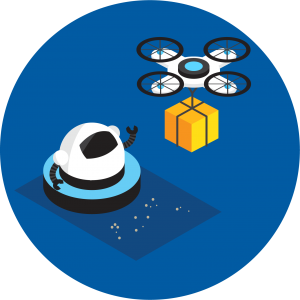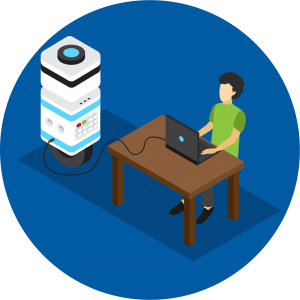
Since the spring semester of 2020, colleges and universities have been in a state of near-constant disruption, managing the ongoing challenges of protecting the health and safety of students, faculty, and staff amid a global health crisis. Over a year later, much has changed, and most of us are eager to return to normal operations (or at least modified but defined operations). Hundreds of colleges have required vaccinations for Fall 2021 enrollment, and other protocols have been rolled out as well. Still, despite having the tools to finally control the COVID-19 pandemic, the heightened need for health and safety on college campuses isn’t going away anytime soon.
Concern for On-Campus Health and Safety Persists
The pandemic has permanently changed how many people perceive public health and safety. You can expect your staff, faculty, students, and their parents to place a higher value on health and safety protocols for the foreseeable future. Demonstrating your institution’s commitment to health and safety will help students, faculty, and staff feel safer coming on campus every day. It will also give parents confidence in sending their students to campus, encourage alumni to return to on-campus events, and attract prospective students to visit and bring their tuition dollars in the future.
How Robots are Making Campuses Cleaner, Healthier, and Safer
Here, robotics is emerging as a key player. The following are just a few ways robots make college campuses a safer, healthier, and more welcoming place post-pandemic.
1. Robots Help Limit the Spread of Illnesses on Campus
Even though vaccines are widely available, until herd immunity is achieved, physical distancing remains important to limit community spread and protect those who cannot be vaccinated and those for whom the vaccines may be less effective. Physical distancing is also valuable for preventing the spread of the flu and other viruses by minimizing person-to-person contact with someone who is ill. After all, physical distancing and other safety measures to slow the spread of COVID-19 also led to historically low flu cases in the 2020-21 season.
 Service and delivery robots are one way to make it easier to maintain distance between a contagious individual—whether they have a virus like COVID-19, the flu, or even the common cold—and others on campus. For example, if a student is unwell, a service robot can deliver food to their room, avoiding direct contact with staff or another student.
Service and delivery robots are one way to make it easier to maintain distance between a contagious individual—whether they have a virus like COVID-19, the flu, or even the common cold—and others on campus. For example, if a student is unwell, a service robot can deliver food to their room, avoiding direct contact with staff or another student.
Furthermore, cleaning robots can thoroughly clean shared spaces any time of the day or night—removing dust, allergens, pathogens, and other debris from high traffic areas, all while being completely contactless. For example, a commercial vacuum cleaner with a HEPA filter can remove 99.97% of particles and clean carpets 50% better compared to manual vacuuming in half the time. Meanwhile, a disinfecting robot with broad-spectrum UV light can remove up to 99% of infection-causing pathogens in just 10 minutes. These robots work alongside facilities maintenance staff to clean to higher standards in less time.
2. Robots Generate Real-Time Data That Improves Safety and Cleanliness
 Robots are connected devices that constantly absorb data about what’s happening around them and report that data in near real-time. There are many ways to use this data to further ensure health and safety, extending beyond the cleaning robots themselves. For example, integrated into an operations dashboard, data from robots and other smart devices can be used to prevent overcrowding in enclosed areas such as laundry rooms, monitor supply and demand of stocked facilities items, and determine whether and when a space needs cleaning again.
Robots are connected devices that constantly absorb data about what’s happening around them and report that data in near real-time. There are many ways to use this data to further ensure health and safety, extending beyond the cleaning robots themselves. For example, integrated into an operations dashboard, data from robots and other smart devices can be used to prevent overcrowding in enclosed areas such as laundry rooms, monitor supply and demand of stocked facilities items, and determine whether and when a space needs cleaning again.
Cleaning robots often communicate via a cellular connection, so your IT group will be pleased that the robots do not touch the campus network.
3. Robots Visually Represent Your Commitment to Health and Safety
It is impossible to miss a robot as they work and engage with people on campus throughout the day. Students and faculty appreciate seeing a cleaning robot working away throughout the day, knowing it is actively making the campus a healthier, safer, and better place. Because of this, robots quickly become a powerful visual reminder of your commitment to well-being. Plus, most service and cleaning robots are “friendly” machines. These robots are small, even a little whimsical. They evoke human curiosity and can quickly put people at ease.
4. Robots Make Happier, More Effective Cleaning Crews
Finally, robots can help you improve your cleaning crew satisfaction and reduce costly turnover by offloading repetitive and mundane tasks, such as vacuuming, that would otherwise consume up to 30% of your teams’ time. Instead, employees can focus on higher-value work that keeps them engaged and motivated.
Incorporating robots into your staff’s workflows also gives cleaning teams the opportunity to work with and learn about cutting-edge automation technology, which can help attract and retain higher-quality talent. Even though cleaning robots move around and clean independently, they still need human input and management for you to get the most value out of the investment.
Cleaning team members that assume the responsibility of robot managers will need to understand how the robot works, including learning about the light detection and ranging (LiDAR) sensors that help the robot navigate and avoid obstacles. They will also learn technical skills and develop mechanical knowledge as they troubleshoot problems, and they’ll also learn how to use data and insights from the analytics dashboards to optimize cleaning operations.
Conclusion
Students, faculty, staff, and alumni have never appreciated the in-person college, workplace, and event experience more. But this fall’s return to classes is an unprecedented one and requires the right technology investments to reopen—and reimagine—daily life on campus.
Brady Watkins is the general manager and senior vice president of SoftBank Robotics America, an international robotics firm based in San Francisco, CA. He can be reached at [email protected]. This is his first article for Facilities Manager.
Technology + Trends
Seeks to identify technology and trends evolving and emerging in educational facilities. To contribute, please contact Craig Park, field editor of this column.
See all Technology + Trends.


